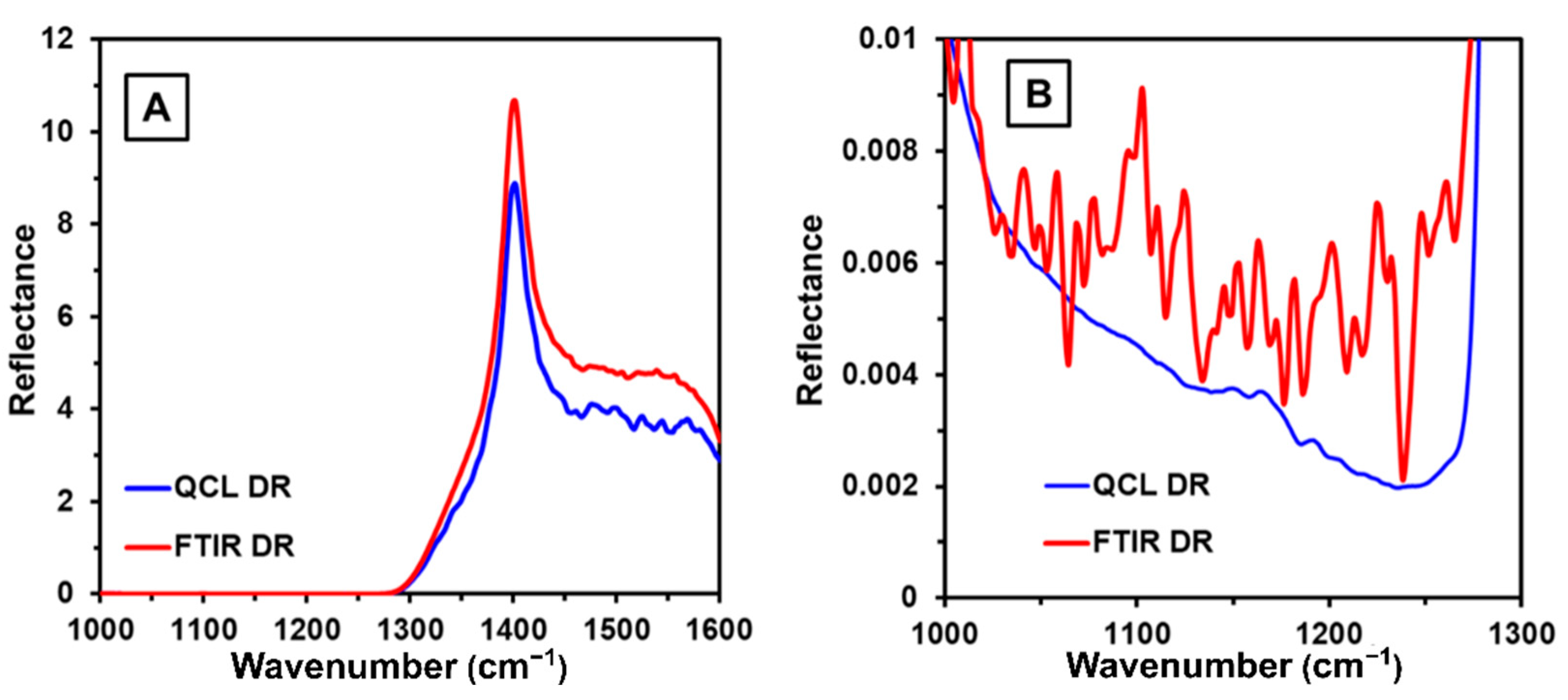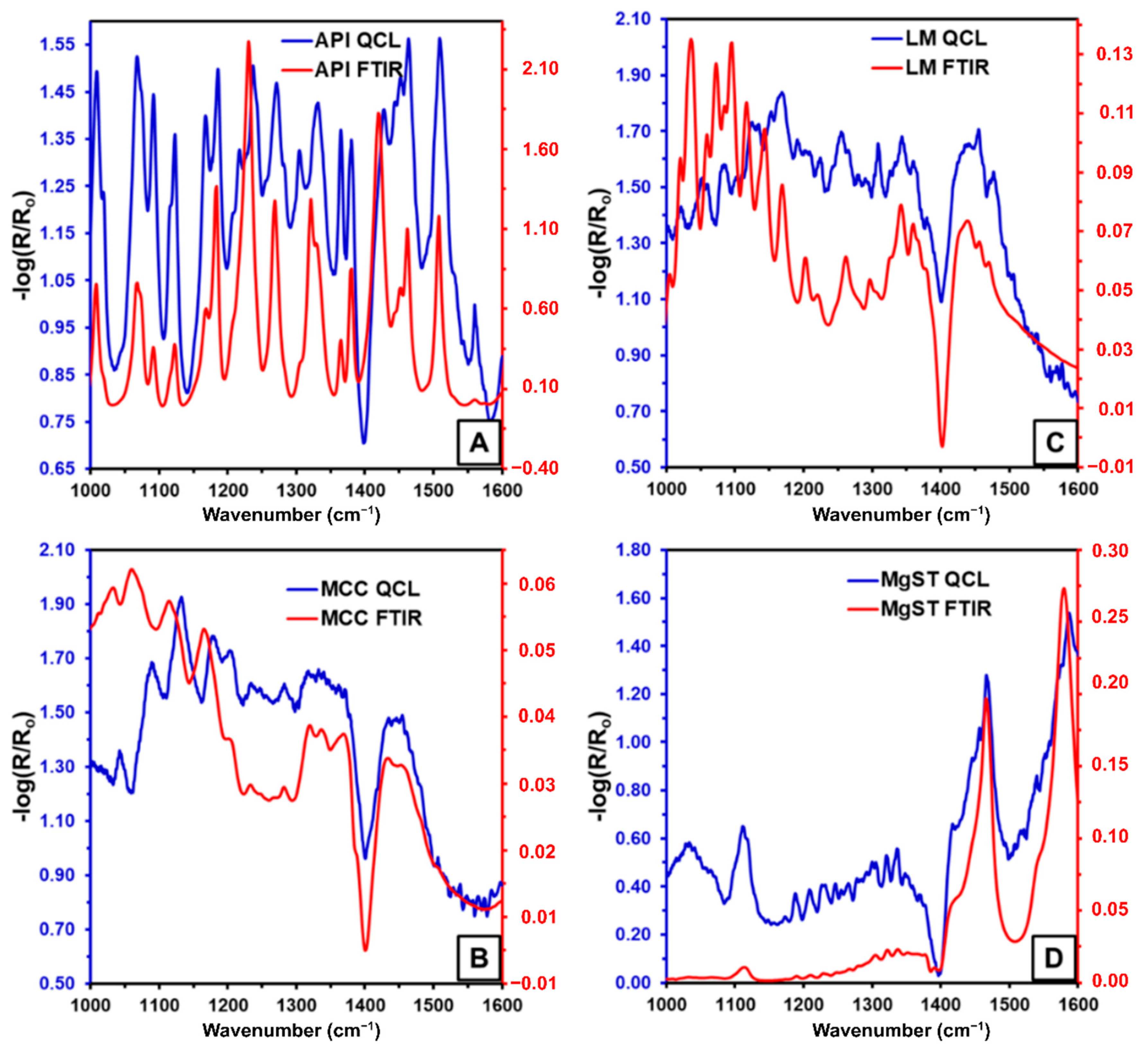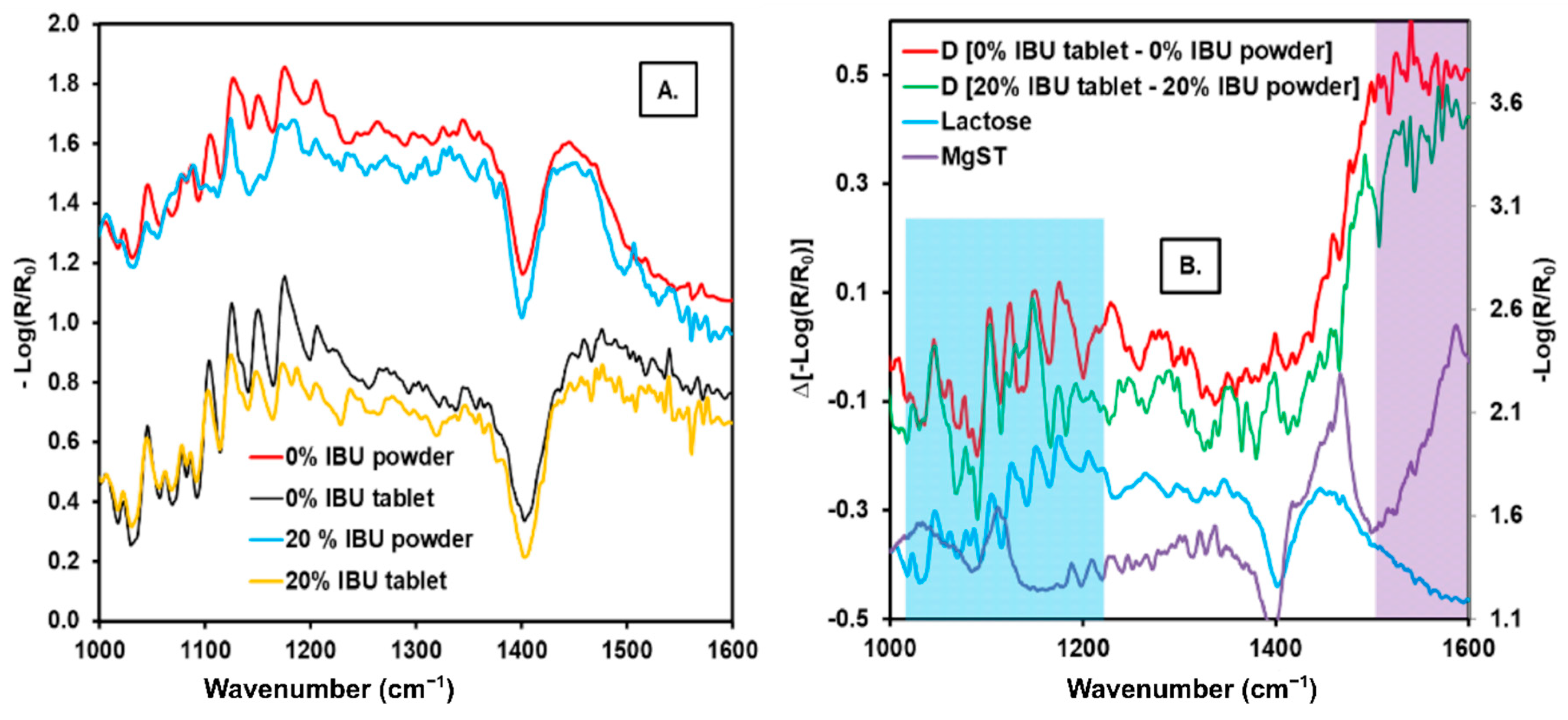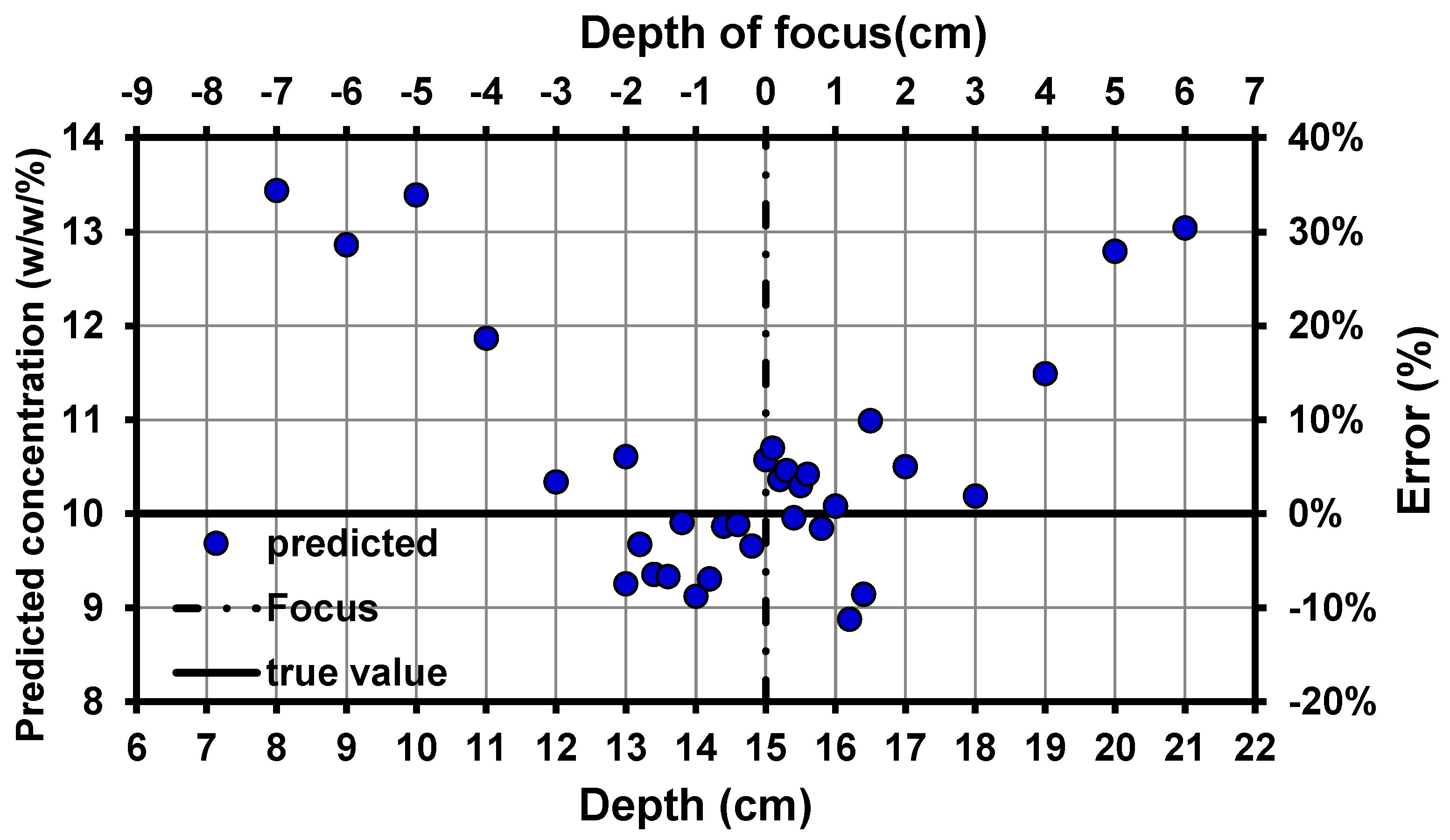API Content and Blend Uniformity Using Quantum Cascade Laser Spectroscopy Coupled with Multivariate Analysis
Abstract
:1. Introduction
2. Materials and Methods
2.1. Reagents and Materials
2.2. Sample Preparation
2.3. QCL Instrument and Data Acquisition
2.4. MIR Multivariate Data Analysis
2.5. Comparison of Spectral Noise FTIR and QCL
3. Results
3.1. Temporary Measures
3.2. Partial Least Squares Models Results
3.3. Effect of Depth of Focus on Predictability
4. Conclusions
Author Contributions
Funding
Institutional Review Board Statement
Informed Consent Statement
Data Availability Statement
Acknowledgments
Conflicts of Interest
References
- Askholt, J.; Nielsen-Kudsk, F. Rapid HPLC-Determination of Ibuprofen and Flurbiprofen in Plasma for Therapeutic Drug Control and Pharmacokinetic Applications. Acta Pharmacol. Toxicol. 1986, 59. [Google Scholar] [CrossRef] [PubMed]
- De Oliveira, A.R.M.; Cesarino, E.J.; Bonato, P.S. Solid-phase microextraction and chiral HPLC analysis of ibuprofen in urine. J. Chromatogr. B Anal. Technol. Biomed. Life Sci. 2005, 818. [Google Scholar] [CrossRef] [PubMed]
- Battu, P.R.; Reddy, M. RP-HPLC method for simultaneous estimation of paracetamol and ibuprofen in tablets. Asian J. Res. Chem. 2009, 2, 70–72. [Google Scholar]
- Tsikas, D.; Kayacelebi, A.A.; Hanff, E.; Mitschke, A.; Beckmann, B.; Tillmann, H.C.; Gutzki, F.M.; Müller, M.; Bernasconi, C. GC–MS and GC–MS/MS measurement of ibuprofen in 10-μL aliquots of human plasma and mice serum using [α-methylo-2H3]ibuprofen after ethyl acetate extraction and pentafluorobenzyl bromide derivatization: Discovery of a collision energy-dependent H/D isotope. J. Chromatogr. B Anal. Technol. Biomed. Life Sci. 2017, 1043, 158–166. [Google Scholar] [CrossRef]
- Issa, Y.M.; Zayed, S.I.M.; Habib, I.H.I. Simultaneous determination of ibuprofen and paracetamol using derivatives of the ratio spectra method. Arab. J. Chem. 2011, 4, 259–263. [Google Scholar] [CrossRef] [Green Version]
- Bahram, M.; Madrakian, T.; Alizadeh, S. Simultaneous colorimetric determination of morphine and ibuprofen based on the aggregation of gold nanoparticles using partial least square. J. Pharm. Anal. 2017, 7. [Google Scholar] [CrossRef] [PubMed]
- Wahbi, A.A.; Hassan, E.; Hamdy, D.; Khamis, E.; Barary, M. Spectrophotometric methods for the determination of Ibuprofen in tablets. Pak. J. Pharm. Sci. 2005, 18, 1–6. [Google Scholar] [PubMed]
- Hernández-Rivera, S.P.; Pacheco-Londoño, L.C.; Ortiz-Rivera, W.; Castro-Suarez, J.R.; Primera-Pedrozo, O.M.; Félix-Rivera, H. Remote raman and infrared spectroscopy detection of high explosives. In Explosive Materials: Classification, Composition and Properties; Nova Science Publishers: Hauppauge, NY, USA, 2011; pp. 231–258. [Google Scholar]
- Castro-Suarez, J.R.; Pacheco-Londoño, L.C.; Aparicio-Bolaño, J.; Hernández-Rivera, S.P. Active Mode Remote Infrared Spectroscopy Detection of TNT and PETN on Aluminum Substrates. J. Spectrosc. 2017, 2017, 2730371. [Google Scholar] [CrossRef] [Green Version]
- Roggo, Y.; Chalus, P.; Maurer, L.; Lema-Martinez, C.; Edmond, A.; Jent, N. A review of near infrared spectroscopy and chemometrics in pharmaceutical technologies. J. Pharm. Biomed. Anal. 2007, 44, 683–700. [Google Scholar] [CrossRef]
- Li, W.; Worosila, G.D. Quantitation of active pharmaceutical ingredients and excipients in powder blends using designed multivariate calibration models by near-infrared spectroscopy. Int. J. Pharm. 2005, 295. [Google Scholar] [CrossRef] [PubMed]
- Wartewig, S.; Neubert, R.H.H. Pharmaceutical applications of Mid-IR and Raman spectroscopy. Adv. Drug Deliv. Rev. 2005, 57, 1144–1170. [Google Scholar] [CrossRef]
- Van Eerdenbrugh, B.; Taylor, L.S. Application of mid-IR spectroscopy for the characterization of pharmaceutical systems. Int. J. Pharm. 2011, 417, 3–16. [Google Scholar] [CrossRef] [PubMed]
- Murayama, K.; Ishikawa, D.; Genkawa, T.; Ozaki, Y. An Application for the Quantitative Analysis of Pharmaceutical Tablets Using a Rapid Switching System Between a Near-Infrared Spectrometer and a Portable Near-Infrared Imaging System Equipped with Fiber Optics. Appl. Spectrosc. 2018, 72, 551–561. [Google Scholar] [CrossRef]
- Ramirez, J.L.; Bellamy, M.K.; Romañach, R.J. A novel method for analyzing thick tablets by near infrared spectroscopy. AAPS PharmSciTech 2001, 2. [Google Scholar] [CrossRef] [Green Version]
- Chalmers, J.M.; Griffiths, P.R. Handbook of Vibrational Spectroscopy; John Wiley & Sons Ltd.: Hoboken, NJ, USA, 2002; Volume 1. [Google Scholar]
- Faist, J.; Capasso, F.; Sirtori, C.; Sivco, D.L.; Baillargeon, J.N.; Hutchinson, A.L.; Chu, S.N.G.; Cho, A.Y. High power mid-infrared (λ∼5 μm) quantum cascade lasers operating above room temperature. Appl. Phys. Lett. 1996, 68, 3680–3682. [Google Scholar] [CrossRef]
- Childs, D.T.D.; Hogg, R.A.; Revin, D.G.; Rehman, I.U.; Cockburn, J.W.; Matcher, S.J. Sensitivity Advantage of QCL Tunable-Laser Mid-Infrared Spectroscopy over FTIR Spectroscopy. Appl. Spectrosc. Rev. 2015, 50, 822–839. [Google Scholar] [CrossRef] [Green Version]
- Kimber, J.A.; Kazarian, S.G. Spectroscopic imaging of biomaterials and biological systems with FTIR microscopy or with quantum cascade lasers. Anal. Bioanal. Chem. 2017, 409, 5813–5820. [Google Scholar] [CrossRef] [Green Version]
- Suter, J.D.; Bernacki, B.; Phillips, M.C. Spectral and angular dependence of mid-infrared diffuse scattering from explosives residues for standoff detection using external cavity quantum cascade lasers. Appl. Phys. B Lasers Opt. 2012, 108, 965–974. [Google Scholar] [CrossRef]
- Liu, X.; Van Neste, C.W.; Gupta, M.; Tsui, Y.Y.; Kim, S.; Thundat, T. Standoff reflection-absorption spectra of surface adsorbed explosives measured with pulsed quantum cascade lasers. Sens. Actuators B Chem. 2014, 191, 450–456. [Google Scholar] [CrossRef]
- Liu, X.; Chae, I.; Miriyala, N.; Lee, D.; Thundat, T.; Kim, S. Broadband Mid-Infrared Stand-Off Reflection–Absorption Spectroscopy Using a Pulsed External Cavity Quantum Cascade Laser. Appl. Spectrosc. 2017, 71, 1494–1505. [Google Scholar] [CrossRef] [PubMed]
- Schwaighofer, A.; Montemurro, M.; Freitag, S.; Kristament, C.; Culzoni, M.J.; Lendl, B. Beyond FT-IR Spectroscopy: EC-QCL based mid-IR Transmission Spectroscopy of Proteins in the Amide I and Amide II Region. Anal. Chem. 2018, acs.analchem.8b01632. [Google Scholar] [CrossRef] [Green Version]
- Pacheco-Londoño, L.C.; Warren, E.; Galán-Freyle, N.J.; Villarreal-González, R.; Aparicio-Bolaño, J.A.; Ospina-Castro, M.L.; Shih, W.-C.; Hernández-Rivera, S.P. Mid-Infrared Laser Spectroscopy Detection and Quantification of Explosives in Soils Using Multivariate Analysis and Artificial Intelligence. Appl. Sci. 2020, 10, 4178. [Google Scholar] [CrossRef]
- Galán-Freyle, N.J.; Ospina-Castro, M.L.; Medina-González, A.R.; Villarreal-González, R.; Hernández-Rivera, S.P.; Pacheco-Londoño, L.C. Artificial Intelligence Assisted Mid-Infrared Laser Spectroscopy In Situ Detection of Petroleum in Soils. Appl. Sci. 2020, 10, 1319. [Google Scholar] [CrossRef] [Green Version]
- Morales-Rodriguez, M.E.; McFarlane, J.; Kidder, M.K. Quantum Cascade Laser Infrared Spectroscopy for Online Monitoring of Hydroxylamine Nitrate. Int. J. Anal. Chem. 2018, 2018, 7896903. [Google Scholar] [CrossRef] [PubMed] [Green Version]
- Genner, A.; Martín-Mateos, P.; Moser, H.; Lendl, B. A Quantum Cascade Laser-Based Multi-Gas Sensor for Ambient Air Monitoring. Sensors 2020, 20, 1850. [Google Scholar] [CrossRef] [Green Version]
- Chen, C.; Ren, Q.; Piao, H.; Wang, P.; Wang, Y. A Trace Carbon Monoxide Sensor Based on Differential Absorption Spectroscopy Using Mid-Infrared Quantum Cascade Laser. Micromachines 2018, 9, 670. [Google Scholar] [CrossRef] [PubMed] [Green Version]
- Ostendorf, R.; Butschek, L.; Hugger, S.; Fuchs, F.; Yang, Q.; Jarvis, J.; Schilling, C.; Rattunde, M.; Merten, A.; Grahmann, J.; et al. Recent Advances and Applications of External Cavity-QCLs towards Hyperspectral Imaging for Standoff Detection and Real-Time Spectroscopic Sensing of Chemicals. Photonics 2016, 3, 28. [Google Scholar] [CrossRef] [Green Version]
- Galán-Freyle, N.J.; Pacheco-Londoño, L.C.; Román-Ospino, A.D.; Hernandez-Rivera, S.P. Applications of Quantum Cascade Laser Spectroscopy in the Analysis of Pharmaceutical Formulations. Appl. Spectrosc. 2016, 70, 1511–1519. [Google Scholar] [CrossRef]
- Pacheco-Londoño, L.C.; Aparicio-Bolaño, J.A.; Galán-Freyle, N.J.; Román-Ospino, A.D.; Ruiz-Caballero, J.L.; Hernandez, S.P. EXPRESS: Classical Least Squares-Assisted MIR Laser Spectroscopy Detection of High Explosives on Fabrics. Appl. Spectrosc. 2018, 73, 000370281878041. [Google Scholar] [CrossRef] [PubMed]
- Classical Least Squares, Part I: Mathematical Theory. Available online: https://www.spectroscopyonline.com/view/classical-least-squares-part-i-mathematical-theory (accessed on 11 April 2021).
- Sanches, N.B.; Cassu, S.N.; Dutra, R.D.C.L. TG/FT-IR characterization of additives typically employed in EPDM formulations. Polímeros 2015, 25, 247–255. [Google Scholar] [CrossRef] [Green Version]
- Nep, E.I.; Conway, B.R. Preformulation studies on grewia gum as a formulation excipient. J. Therm. Anal. Calorim. 2011, 108, 197–205. [Google Scholar] [CrossRef]
- Li, C.; Zhang, D.; Slipchenko, M.N.; Cheng, J.-X. Mid-Infrared Photothermal Imaging of Active Pharmaceutical Ingredients at Submicrometer Spatial Resolution. Anal. Chem. 2017, 89, 4863–4867. [Google Scholar] [CrossRef]







| Type of Sample | Tablets/Powder Blends |
|---|---|
| Total number of samples | 21 |
| Number of QCL spectra per sample | 20 |
| Calibration set | 14 |
| External validation set | 7 |
| API concentration level for the calibration set | 0.00%, 1.10%, 3.17%, 5.15%, 7.65%, 9.53%, 11.57%, 12.39%, 14.06%, 15.44%, 16.10%, 17.22%, 18.68%, and 21.67% |
| API concentration level for the external validation set | 2.20%, 6.37%, 10.06%, 11.74%, 14.38%, 16.98%, and 19.36% |
| Calibration Test | |||||
|---|---|---|---|---|---|
| Sample | Preprocess | RMSEC (%) | RMSECV (%) | R2CV | BiasCV |
| Tablets | None | 1.68 | 1.69 | 0.933 | −0.02 |
| SNV | 1.33 | 1.38 | 0.955 | −0.0009 | |
| SG-1D + SNV | 1.13 | 1.16 | 0.968 | −0.004 | |
| Powder | None | 1.33 | 1.34 | 0.958 | −0.06 |
| Blend | SNV | 0.75 | 0.77 | 0.986 | −0.001 |
| SG-1D + SNV | 0.767 | 0.787 | 0.985 | 0.0002 | |
| Test Set | |||||
| Sample | Preprocess | R2Pred | RMSEP (%) | RSEP (%) | LVs |
| Tablets | None | 0.825 | 3.11 | 2.93 | 2 |
| SNV | 0.942 | 1.95 | 1.16 | 3 | |
| SG-1D + SNV | 0.963 | 1.38 | 0.58 | 4 | |
| Powder | None | 0.928 | 2.15 | 1.42 | 2 |
| Blend | SNV | 0.973 | 1.16 | 0.41 | 3 |
| SG-1D + SNV | 0.972 | 1.18 | 0.43 | 3 | |
| Sample | Spectral Preprocessing | Diodes | Spectral Region (cm−1) | RMSECV (%) | RMSEP (%) |
|---|---|---|---|---|---|
| Tablets | SG-1D + SNV | D1 | 990–1111 | 2.05 | 2.49 |
| D2 | 1111–1178 | 1.82 | 2.28 | ||
| D3 | 1178–1600 | 1.33 | 1.8 | ||
| Powder | SNV | D1 | 990–1111 | 1.29 | 2.51 |
| D2 | 1111–1178 | 1.19 | 2.56 | ||
| D3 | 1178–1600 | 0.92 | 1.33 |
Publisher’s Note: MDPI stays neutral with regard to jurisdictional claims in published maps and institutional affiliations. |
© 2021 by the authors. Licensee MDPI, Basel, Switzerland. This article is an open access article distributed under the terms and conditions of the Creative Commons Attribution (CC BY) license (https://creativecommons.org/licenses/by/4.0/).
Share and Cite
Villanueva-López, V.; Pacheco-Londoño, L.C.; Villarreal-González, R.; Castro-Suarez, J.R.; Román-Ospino, A.; Ortiz-Rivera, W.; Galán-Freyle, N.J.; Hernandez-Rivera, S.P. API Content and Blend Uniformity Using Quantum Cascade Laser Spectroscopy Coupled with Multivariate Analysis. Pharmaceutics 2021, 13, 985. https://doi.org/10.3390/pharmaceutics13070985
Villanueva-López V, Pacheco-Londoño LC, Villarreal-González R, Castro-Suarez JR, Román-Ospino A, Ortiz-Rivera W, Galán-Freyle NJ, Hernandez-Rivera SP. API Content and Blend Uniformity Using Quantum Cascade Laser Spectroscopy Coupled with Multivariate Analysis. Pharmaceutics. 2021; 13(7):985. https://doi.org/10.3390/pharmaceutics13070985
Chicago/Turabian StyleVillanueva-López, Vladimir, Leonardo C. Pacheco-Londoño, Reynaldo Villarreal-González, John R. Castro-Suarez, Andrés Román-Ospino, William Ortiz-Rivera, Nataly J. Galán-Freyle, and Samuel P. Hernandez-Rivera. 2021. "API Content and Blend Uniformity Using Quantum Cascade Laser Spectroscopy Coupled with Multivariate Analysis" Pharmaceutics 13, no. 7: 985. https://doi.org/10.3390/pharmaceutics13070985







